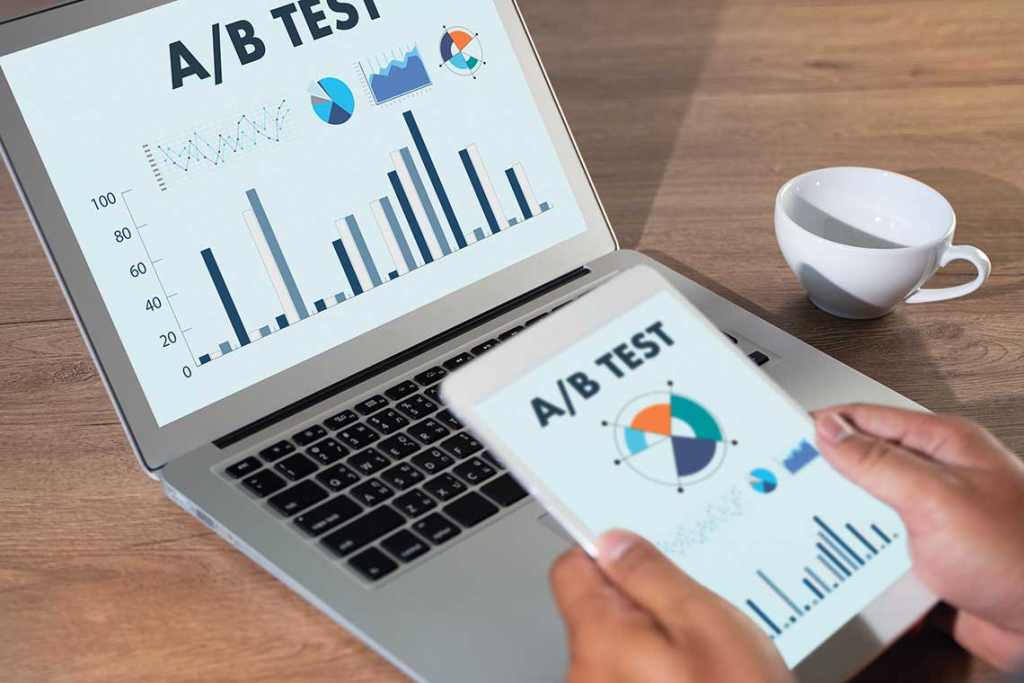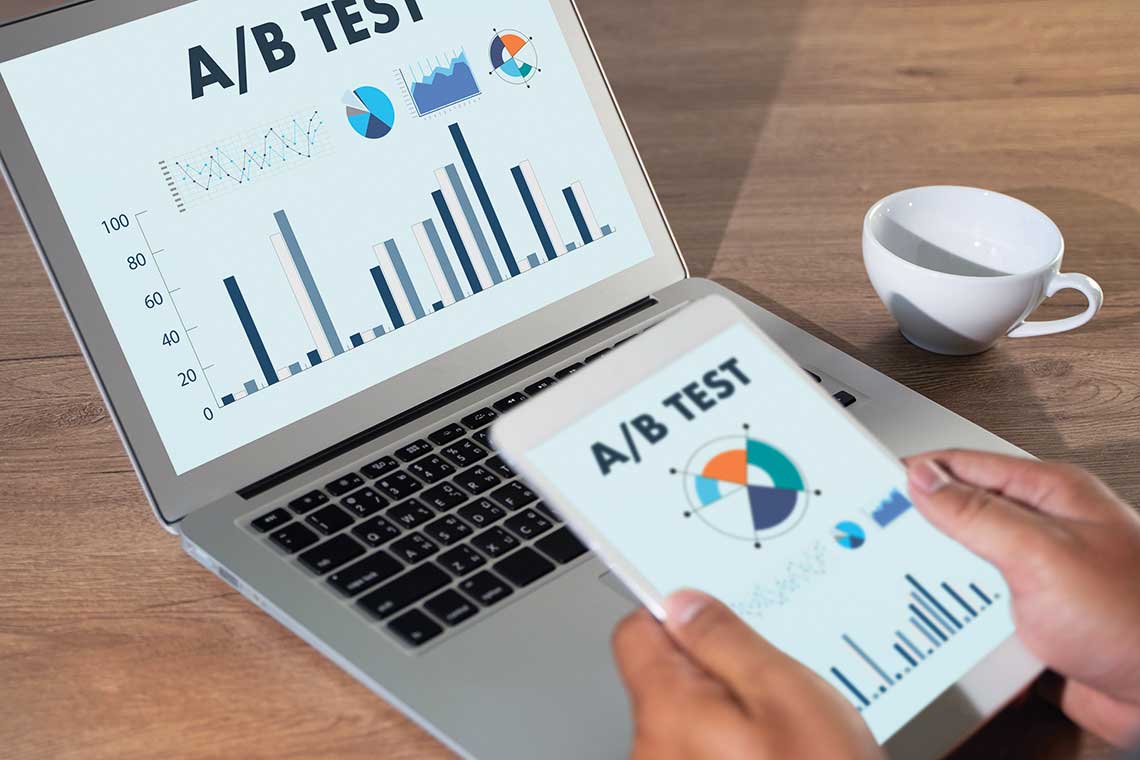A/B Testing Market Research

Ever wondered how some brands manage to understand precisely what their customers desire? The answer lies in A/B testing market research. This market research not only helps in making informed decisions but also allows businesses to understand their audience’s preferences, behaviors, and tailor their offerings – ensuring they are optimally aligned with market demands and consumer expectations.
What is A/B Testing Market Research?
A/B testing is a method of research that shows two versions of an app or web page to an audience to test user engagement. In other words, It operates by testing between two versions to see which performs better. AB testing compares a variation against the current model. Then, it lets you ask focused questions about changes in your web page or app. You can then use those questions to collect data on the impact of those changes. A/B testing in market research allows business owners to see the effect of potential adjustments. It shows them the impact their advertising will have on consumer activity. The original version of the page is the “Control,” and the modified version is the “Variation.”
Let’s look at a hypothetical example:
A clothing and apparel website is trying to find out what look for its new website will bring in the most sales. Note that their current page is bringing in about $3000 in sales per month. They want to do AB testing to see how a change would alter their profits.
Let’s look at the results:
Version 1 (V1) Change the headline of the page. The Original pulls in $1500 in profit, and V1 pulls in $1250
Version 2 (V2) Change in The visual imagery of the page. The original pulls in $1450 in profit, and V2 pulls in $1750. Version 3 (V3) Change the page’s layout. The control draws in $1550 in profit, and V2 pulls in $2500
From these tests, we can gather a few things. We can see that a variation in the page may negatively or positively affect sales. Version 1 showed that a change to the page’s header reduces the page’s sales by 17%. Thus, we can see the customers disliked the alteration and that it be best to limit changes like those.
In Version 2, the visual imagery changed, and there was an uptick in sales. We could speculate why there was a boost in sales. The new imagery may have fit the color scheme of the site better. Additionally, the photography may have looked more professional. Thus, it’s easy to see how A/B Testing can help find out the best look for your app or web page. Finally, let’s look at Version 3. It has boosted revenue by 67%. In other words, this change created the most significant increase in sales. We can see that adjusting the page’s layout is the most impactful. So, that change would be the best move to make.
Why Is “A/B Testing Market Research” Important Today?
A/B testing market research is crucial for understanding and responding to consumer behavior in real-time. With users’ attention spans decreasing, businesses have a limited window to capture interest and convert leads. It provides immediate feedback on what works and what doesn’t, allowing brands to tweak and optimize their online content swiftly and effectively.
Furthermore, A/B testing market research offers the kind of precise, actionable data that businesses need to thrive. The insights derived from A/B testing are concrete and based on actual user interactions, providing a reliable foundation for making informed marketing and product development decisions. Thus, engaging in A/B testing market research is essentially engaging in a process of continuous improvement and refinement, fostering a culture of innovation and responsiveness within the organization.
Here are some other benefits of A/B testing market research:
• Data-Driven Decision-Making: Market research facilitates decisions grounded in data, mitigating the risk of reliance on intuition or gut feeling. This empirical approach ensures that every modification, no matter how minute, is justified by concrete data, enhancing the efficacy and impact of the changes implemented.
• Enhanced User Experience: Through continual testing and optimization processes, businesses can craft an online experience that resonates with their audience. The methodology enables the refinement of elements that contribute to a more intuitive and user-friendly interface, fostering higher engagement and satisfaction among users.
• Increased Conversion Rates: One of the standout benefits of A/B testing market research is its direct contribution to improving conversion rates. By understanding what appeals to visitors, businesses can make the necessary adjustments to their webpages, leading to a higher percentage of visitors taking the desired action, whether it’s making a purchase, signing up for a newsletter, or downloading a resource.
• Cost-Efficiency: A/B testing market research is a cost-effective method for optimizing online assets. Instead of investing heavily in large-scale changes without guaranteed returns, businesses can test smaller elements, assessing their impact and implementing them if they prove effective. This approach ensures that resources are utilized efficiently, with expenditures directly correlating to improvements in performance.
• Risk Mitigation: By testing changes with a segment of the audience before a full-scale rollout, businesses mitigate the risks associated with website redesign or major updates. This process allows for the identification and rectification of issues before they can affect the broader user base, safeguarding against potential negative impacts on brand reputation and customer loyalty.
• Personalization: A/B testing market research supports the development of personalized content and features. Through analyzing how different segments of the audience respond to various elements, businesses can tailor their offerings to meet the specific needs and preferences of different user groups, enhancing relevance and appeal.
• Increasing Return on Investment (ROI): Since A/B testing market research is fundamentally about optimization, it naturally leads to better utilization of resources and improved returns on investment. When changes are tested and validated, businesses can be confident that their investments in development and marketing are likely to yield positive results.
Key Job Titles
Some notable jobs for effective research include:
- Data Scientist
- Market Research Analyst
- Accessibility tester
- Test Automation Engineer
Key Success Factors
AB testing involves a lot of IT processing, and so it will need specialized persons. It’s essential to run the tests. Additionally, it’s good to run many trials of different variables. This method lets you understand the effect each aspect of your webpage or app screen has on consumers. Furthermore, It’s also essential to make them specific so that your info is more in-depth and valuable.
Challenges of A/B Testing Market Research
While A/B testing market research offers unparalleled insights and opportunities for optimization. However, it comes with its own set of challenges that businesses need to navigate to be a really successful company.
• Data Misinterpretation: One of the primary challenges with A/B testing market research is the risk of misinterpreting the data. Incorrect analysis can lead to flawed conclusions and misguided changes, potentially causing more harm than good to the user experience and conversion rates.
• Statistical Significance: Achieving statistical significance is crucial for the reliability of A/B testing market research results. Small sample sizes or premature testing can lead to inconclusive or misleading findings, necessitating careful planning and execution of tests.
• Resource Intensive: Although A/B testing market research is cost-effective, it demands time, expertise, and dedicated resources to plan, execute, analyze, and implement the findings. Small businesses or startups might find it challenging to allocate sufficient resources for continuous A/B testing.
• Technology Dependence: A/B testing market research relies heavily on technology and tools. Any technical glitches, software errors, or issues with the testing platform can impact the accuracy and reliability of the test results, making it crucial to invest in reliable technology and maintain it regularly.
Future Outlook of A/B Testing Market Research
A/B testing market research holds promising potential for businesses aiming for precision and efficiency. Thus, the future outlook of this market research is bright, with emerging trends and technologies further enhancing its applicability and value.
• Integration with Artificial Intelligence (AI): The future of A/B testing market research is closely intertwined with advancements in AI. AI can automate the analysis of test results, identifying patterns and insights that might be overlooked by human analysts. This not only speeds up the testing process but also brings a level of precision and accuracy that is unparalleled.
• Personalization at Scale: With A/B testing market research becoming more sophisticated, businesses will be able to achieve personalization at an unprecedented scale. Understanding nuanced customer behaviors and preferences will allow for the creation of highly personalized user experiences, which are crucial for customer retention and engagement in the digital age.
• Real-time Optimization: The future promises the advent of tools and technologies enabling real-time A/B testing market research and optimization. This will allow businesses to make instant adjustments to their online content and marketing strategies, responding promptly to user behavior and market trends.
• Cross-Platform Testing: With users accessing content across a multitude of devices, cross-platform market research will become increasingly vital. Future tools and technologies will facilitate seamless testing across different devices and platforms, ensuring a consistent and engaging user experience irrespective of the access point.
• Community-Driven Insights: With the rise of social media and online communities, A/B testing market research will increasingly incorporate insights and feedback from these platforms. This approach will offer a more holistic understanding of user preferences and behaviors, driving more informed and effective testing and optimization strategies.
About A/B Testing Market Research
A/B testing uses a blend of qualitative and quantitative research. It’s focused on identifying what to change and how to change it. Additionally, it quantifies what changes are better or worse. You see how much they affect sales. This technology is an excellent addition to a business’s toolkit, but it can’t cover everything. So, it’s good to use focus groups, interviews, and surveys in your methods to get the best information.



